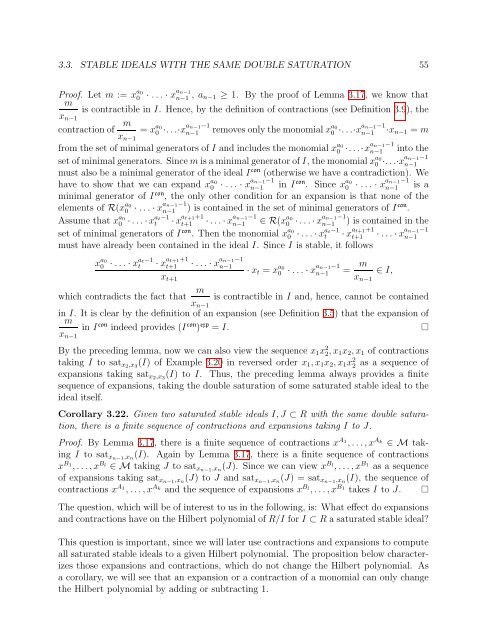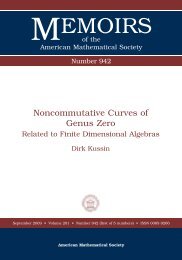University of Paderborn Department of Mathematics Diploma Thesis ...
University of Paderborn Department of Mathematics Diploma Thesis ...
University of Paderborn Department of Mathematics Diploma Thesis ...
Create successful ePaper yourself
Turn your PDF publications into a flip-book with our unique Google optimized e-Paper software.
3.3. STABLE IDEALS WITH THE SAME DOUBLE SATURATION 55Pro<strong>of</strong>. Let m := x a 00 · . . . · x a n−1n−1 , a n−1 ≥ 1. By the pro<strong>of</strong> <strong>of</strong> Lemma 3.17, we know thatmis contractible in I. Hence, by the definition <strong>of</strong> contractions (see Definition 3.9), thex n−1mcontraction <strong>of</strong> = x a 00 ·. . .·x a n−1−1n−1 removes only the monomial x a 00 ·. . .·x a n−1−1n−1 ·x n−1 = mx n−1from the set <strong>of</strong> minimal generators <strong>of</strong> I and includes the monomial x a 00 ·. . .·x a n−1−1n−1 into theset <strong>of</strong> minimal generators. Since m is a minimal generator <strong>of</strong> I, the monomial x a 00 ·. . .·x a n−1−1n−1must also be a minimal generator <strong>of</strong> the ideal I con (otherwise we have a contradiction). Wehave to show that we can expand x a 00 · . . . · x a n−1−1n−1 in I con . Since x a 00 · . . . · x a n−1−1n−1 is aminimal generator <strong>of</strong> I con , the only other condition for an expansion is that none <strong>of</strong> theelements <strong>of</strong> R(x a 00 · . . . · x a n−1−1n−1 ) is contained in the set <strong>of</strong> minimal generators <strong>of</strong> I con .Assume that x a 00 · . . . · x at−1t · x a t+1+1t+1 · . . . · x a n−1−1n−1 ∈ R(x a 00 · . . . · x a n−1−1n−1 ) is contained in theset <strong>of</strong> minimal generators <strong>of</strong> I con . Then the monomial x a 00 · . . . · x at−1t · x a t+1+1t+1 · . . . · x a n−1−1n−1must have already been contained in the ideal I. Since I is stable, it followsx a 00 · . . . · x at−1t· x a t+1+1t+1 · . . . · x a n−1−1n−1· x t = x a 00 · . . . · x a n−1−1n−1 = m ∈ I,x t+1 x n−1mwhich contradicts the fact that is contractible in I and, hence, cannot be containedx n−1in I. It is clear by the definition <strong>of</strong> an expansion (see Definition 3.5) that the expansion <strong>of</strong>min I con indeed provides (I con ) exp = I.x n−1By the preceding lemma, now we can also view the sequence x 1 x 2 2, x 1 x 2 , x 1 <strong>of</strong> contractionstaking I to sat x2 ,x 3(I) <strong>of</strong> Example 3.20 in reversed order x 1 , x 1 x 2 , x 1 x 2 2 as a sequence <strong>of</strong>expansions taking sat x2 ,x 3(I) to I. Thus, the preceding lemma always provides a finitesequence <strong>of</strong> expansions, taking the double saturation <strong>of</strong> some saturated stable ideal to theideal itself.Corollary 3.22. Given two saturated stable ideals I, J ⊂ R with the same double saturation,there is a finite sequence <strong>of</strong> contractions and expansions taking I to J.Pro<strong>of</strong>. By Lemma 3.17, there is a finite sequence <strong>of</strong> contractions x A 1, . . . , x A k ∈ M takingI to sat xn−1 ,x n(I). Again by Lemma 3.17, there is a finite sequence <strong>of</strong> contractionsx B 1, . . . , x B l ∈ M taking J to satxn−1 ,x n(J). Since we can view x B l , . . . , xB 1as a sequence<strong>of</strong> expansions taking sat xn−1 ,x n(J) to J and sat xn−1 ,x n(J) = sat xn−1 ,x n(I), the sequence <strong>of</strong>contractions x A 1, . . . , x A k and the sequence <strong>of</strong> expansions xB l, . . . , xB 1takes I to J.The question, which will be <strong>of</strong> interest to us in the following, is: What effect do expansionsand contractions have on the Hilbert polynomial <strong>of</strong> R/I for I ⊂ R a saturated stable ideal?This question is important, since we will later use contractions and expansions to computeall saturated stable ideals to a given Hilbert polynomial. The proposition below characterizesthose expansions and contractions, which do not change the Hilbert polynomial. Asa corollary, we will see that an expansion or a contraction <strong>of</strong> a monomial can only changethe Hilbert polynomial by adding or subtracting 1.
















